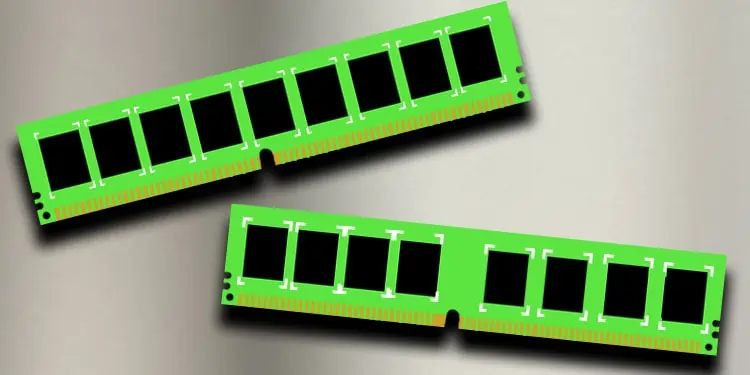Depending on your motherboard and what you use the system for, you can either install RAM that detects and corrects memory errors (ECC RAM) or one that doesn’t (Non-ECC RAM).
ECC memory can fix memory errors in RAM. Using ECC memory lowers the risk of system crashes, server failure, and data corruption. Non-ECC memory, on the other hand, cannot fix memory errors. Some non-ECC memory may come with support for memory errors detection but not correction.
So which one is better? The answer depends on one major factor, the system’s usage. If you have a workstation PC, running a database server, or performing real-time calculations where accuracy is crucial, you need an ECC RAM in your system.
For most average consumers, a system with non-ECC RAM will work fine, just that the system won’t be able to correct memory errors. However, if you want that extra shield of protection from data corruption, it makes sense to use an ECC RAM.
ECC RAM
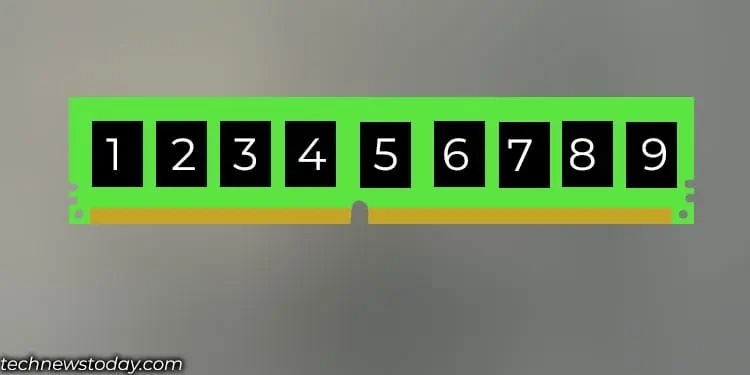
ECC RAM is a popular type of memory that uses a parity bit in its memory address to detect and correct single bit memory errors. It can also detect dual-bit errors but cannot correct them.
The change in memory bits could occur due to corruption in memory address, error in memory timing , software bugs, or external hardware issues. To fix this, ECC memory uses a separate parity bit that keeps track of total number of 0’s or 1’s in a memory block.
Suppose a single bit from the memory block is changed. Say 0 changes to 1. Now, when accessing the data from the memory block, an algorithm uses the parity bit to check whether the data is altered.
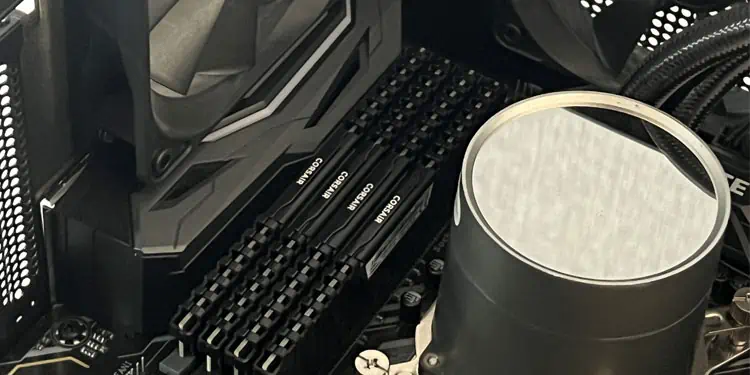
These types of memory are specifically used in huge workstations and server computers, where data accuracy is of the utmost importance.
In workstation computers or database servers, crucial user data or information are constantly passed through RAM for the CPU to process. If these data are corrupted or if incorrect data is stored, correcting these mishaps could take weeks or even months when using non-ECC RAM.
Memory error on such a server that’s processing millions of data, or calculating real-time data can lead to catastrophic outcomes.
ECC RAM can instantly detect and correct these types of errors. It accurately detects single-bit errors in the memory address block and corrects them without any user interruption.
Once the memory detects and corrects a single-bit error in the memory address, it displays a Machine Check Exception warning in the Event Log.
The important thing to note here is ECC memory is mostly used to prevent data corruption and provide system stability. Although ECC RAM makes the system more stable compared to non-ECC RAM, avoiding data corruption is where it mostly shines.
One downside to ECC RAM would be that these RAM usually come with lower RAM speeds. DDR4 ECC RAM comes up to a max speed of 3200 MT/s. DDR5 ECC RAM, on the other hand, has a speed up to 5200 MT/s.
Non-ECC RAM
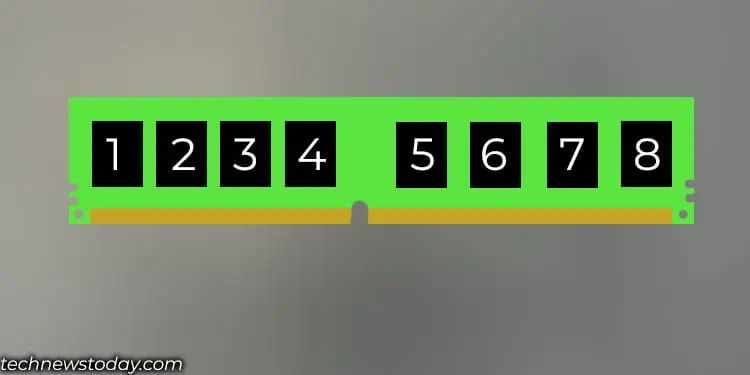
As the name suggests, non-ECC RAM does not support error correction. Non-ECC RAM is general-purpose RAM used on most consumer-level computers. It does not have parity support, and it cannot correct single or dual memory bit errors.
The non-ECC unit shines in speed. Lack of support for error detection makes it faster compared to the ECC memory module by about 2%. This is because it does not take extra time to check for memory errors.
Besides this, non-ECC RAM also comes with higher transfer rates compared to ECC RAM. You can find DDR4 non-ECC RAM with transfer speeds reaching up to 4600 MHz and DDR5 RAM up to 8000MHz.
A few years ago, I ran into data corruption with a non-ECC module. This happened when I copied data from one storage device to the other one. The copied video had numerous silent corruption, with some visual glitches, and the text on the files was scattered at random places.
Once I ran a memory test, it displayed that the memory test had failed with numerous memory block errors. These errors and data corruption would have been detected and even corrected if I was using ECC memory.
ECC v Non-ECC
Now that you know about ECC and non-ECC memory, let’s see how it’s different in terms of internal architecture, use case, compatibility, and many more.
Architecture and Use Case
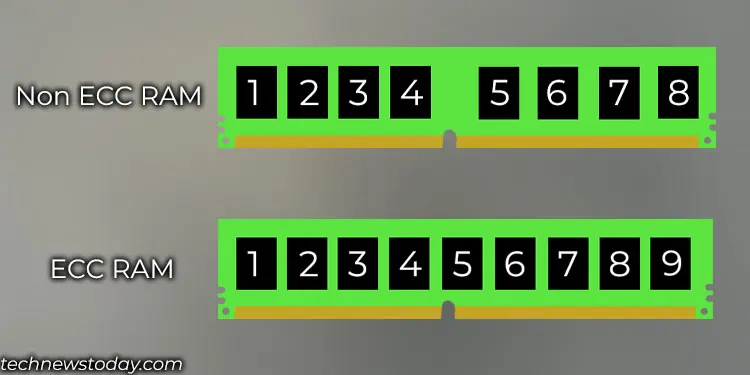
Non-ECC modules have a total of 8, 16, 32, and so on memory chips, depending on the capacity. The ECC memory stick contains an extra chip for each 8 memory chip (9, 18, or 36 in total), depending on memory capacity to detect and correct memory errors.
The extra chip stores parity bit information for error correction. Memory with ECC also uses a separate 8-bit bus. Non-ECC RAM does not have this chip, and data is directly transferred and accessed using a 64-bit bus and does not contain a separate 8-bit bus.
This extra layer of security on the ECC memory module makes it a perfect choice for a computer that has to process high-value data.
Non-ECC RAM, on the other hand, is for the average consumer, where the system does not process critical data. The RAM you use on your day-to-day laptop or computer is likely a non-ECC memory.
Motherboard and CPU Compatibility
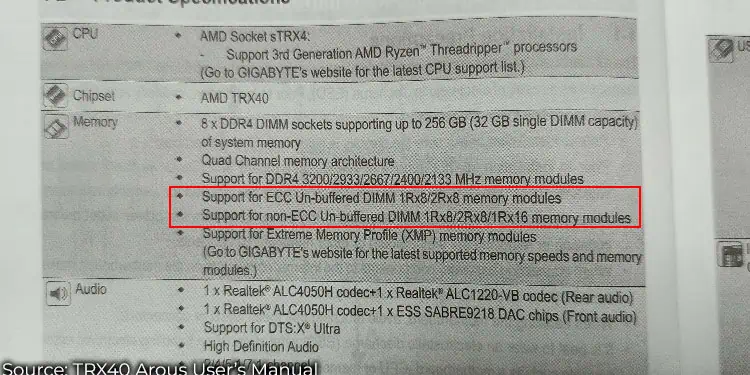
ECC RAM requires a motherboard and a CPU that supports ECC. You can also pair a non-ECC RAM with a motherboard and CPU that supports ECC. The system might boot, but it cannot detect and correct any memory errors.
Non-ECC RAM does not have a slot requirement. You can install it on any motherboard and CPU as long as you have the correct form factor and DDR version.
On the contrary, installing an ECC RAM on a non-ECC motherboard may or may not work. If you are using an unbuffered ECC RAM, the non-ECC motherboard may boot up, but you will not have the ECC functionality.
Buffered/registered ECC, on the other hand, will not work on a non-ECC motherboard.
Transfer Rates
ECC RAM and non-ECC run at similar speeds, given that both have the same frequency. However, since ECC RAM needs more processing to detect and correct errors, ECC RAM is slightly slower than non-ECC RAM.
For general users, the change in speed between ECC RAM and non-ECC RAM is not noticeable unless you look at the benchmark results.
Price
Due to the extra memory chip for error correction on ECC RAM, it is slightly expensive to manufacture compared to non-ECC RAM. This also increases the retail price for ECC RAM.
Overall, the price of the ECC memory module is 10-25% higher compared to the non-ECC unit of the same RAM frequency and capacity.
Final Thoughts
Both these types of RAM have specific usage. The main purpose of an ECC RAM is to detect and correct errors in memory bits. This provides system stability, prevents data corruption, and is generally used on servers that run 24/7 or on systems that process sensitive data.
For general usage, you can install a non-ECC RAM, and you likely won’t need an ECC RAM.

